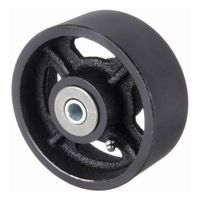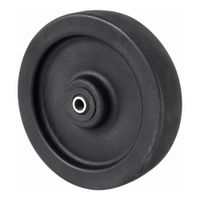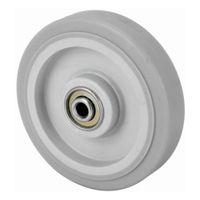Call +(254) 703 030 000 / 751 483 999 / 721 704 777
- Home
- Material Handling
- Casters Wheels
- Caster Wheels
.....Read More
Frequently Asked Questions
What are caster wheels used for?
Caster wheels are versatile components used to facilitate the movement of objects, equipment, and furniture by providing a rolling mechanism. They are commonly found in various settings, including industrial, commercial, and residential environments. Here are some key uses and benefits of caster wheels:
1. **Mobility**: Caster wheels enable the easy movement of heavy or bulky items, reducing the physical strain on individuals and improving efficiency in transporting goods or equipment.
2. **Versatility**: Available in different sizes, materials, and designs, caster wheels can be tailored to specific needs, such as carrying heavy loads, navigating uneven surfaces, or providing smooth and quiet operation.
3. **Space Optimization**: By allowing objects to be easily moved, caster wheels help in optimizing space usage. Furniture or equipment can be rearranged or stored efficiently, making them ideal for dynamic environments like workshops, warehouses, and offices.
4. **Safety**: Caster wheels can enhance safety by reducing the need for lifting and carrying heavy items, thus minimizing the risk of injuries. Locking mechanisms on some caster wheels also prevent unwanted movement, adding stability when needed.
5. **Industrial Applications**: In manufacturing and warehousing, caster wheels are essential for moving machinery, tools, and inventory. They support productivity by enabling quick and easy repositioning of equipment.
6. **Medical and Hospitality Sectors**: In hospitals and hotels, caster wheels are used on beds, carts, and trolleys to ensure smooth and efficient service delivery, enhancing both patient care and guest experience.
7. **Furniture and Home Use**: Caster wheels are often used on chairs, tables, and storage units, providing flexibility in home and office settings. They allow for easy cleaning and rearrangement of spaces.
Overall, caster wheels are crucial for enhancing mobility, efficiency, and safety across various applications, making them indispensable in many industries and everyday life.
How do you choose the right caster wheel for a specific application?
To choose the right caster wheel for a specific application, consider the following factors:
1. **Load Capacity**: Determine the total weight the caster needs to support, including the weight of the equipment and any additional load. Divide the total weight by the number of casters to find the required load capacity per caster.
2. **Wheel Material**: Select a material based on the floor surface and environment. Hard materials like steel or cast iron are suitable for smooth, hard surfaces, while softer materials like rubber or polyurethane are better for uneven or delicate surfaces.
3. **Floor Conditions**: Assess the floor type and condition. For rough or uneven surfaces, larger wheels with softer treads are preferable. For smooth surfaces, smaller, harder wheels may suffice.
4. **Environment**: Consider environmental factors such as temperature, moisture, and exposure to chemicals. Stainless steel or nylon wheels are ideal for wet or corrosive environments, while rubber or polyurethane are better for dry, indoor settings.
5. **Mobility Requirements**: Determine the type of movement needed. Swivel casters allow for greater maneuverability, while rigid casters provide straight-line stability. For applications requiring both, a combination of swivel and rigid casters is ideal.
6. **Mounting Type**: Choose between plate, stem, or bolt-hole mounting based on the equipment design and installation requirements.
7. **Wheel Diameter**: Larger wheels roll more easily over obstacles and require less force to move, making them suitable for heavy loads or rough surfaces.
8. **Braking and Locking**: If stability is crucial, consider casters with brakes or locks to prevent unwanted movement.
9. **Noise Levels**: For noise-sensitive environments, select wheels made from materials like rubber or polyurethane that absorb sound.
10. **Cost and Durability**: Balance cost with durability and performance requirements to ensure long-term efficiency and value.
What materials are caster wheels made from?
Caster wheels are manufactured from a variety of materials, each offering distinct characteristics suited to different applications. Common materials include:
1. **Rubber**: Known for its quiet operation and shock absorption, rubber caster wheels are ideal for indoor use on hard surfaces. They provide good traction and protect floors from damage.
2. **Polyurethane**: These wheels offer a balance between rubber and plastic, providing durability and a smooth ride. They are resistant to chemicals and abrasion, making them suitable for both indoor and outdoor use.
3. **Nylon**: Lightweight and resistant to wear, nylon wheels are often used in environments where chemical resistance is important. They are suitable for heavy loads and can operate on a variety of surfaces.
4. **Polypropylene**: Similar to nylon, polypropylene wheels are lightweight and resistant to chemicals. They are cost-effective and often used in applications where the load is not excessively heavy.
5. **Metal**: Steel and cast iron wheels are extremely durable and can carry heavy loads. They are typically used in industrial settings where the floor surface is rough or uneven. However, they can be noisy and may damage floors.
6. **Phenolic**: Made from a combination of phenolic resin and macerated fabric, these wheels are heat-resistant and can handle heavy loads. They are often used in environments with high temperatures.
7. **Thermoplastic Elastomer (TPE)**: Combining the properties of rubber and plastic, TPE wheels offer good shock absorption and are non-marking, making them suitable for sensitive flooring.
8. **Aluminum**: Lightweight and corrosion-resistant, aluminum wheels are used in environments where moisture is a concern. They are durable and can handle moderate loads.
Each material is chosen based on factors such as load capacity, floor type, environmental conditions, and cost considerations.
How do you install caster wheels on equipment?
To install caster wheels on equipment, follow these steps:
1. **Select Appropriate Casters**: Choose casters based on the equipment's weight, the floor surface, and mobility requirements. Ensure the casters have the correct load capacity and wheel type.
2. **Gather Tools and Materials**: You will need a drill, drill bits, a wrench, screws or bolts, a measuring tape, and a pencil or marker.
3. **Prepare the Equipment**: Elevate the equipment using a jack or blocks to access the bottom. Ensure it is stable and secure to prevent accidents.
4. **Mark Mounting Locations**: Use the measuring tape to mark the positions for the casters on the equipment's base. Ensure the marks are evenly spaced and aligned for stability.
5. **Drill Holes**: If the equipment does not have pre-drilled holes, use the drill and appropriate bit to create holes at the marked locations. The hole size should match the screws or bolts.
6. **Attach the Casters**: Align the caster's mounting plate with the drilled holes. Insert screws or bolts through the caster plate and into the equipment. Use a wrench to tighten them securely. For swivel casters, ensure they can rotate freely.
7. **Test the Installation**: Lower the equipment and test the casters by moving the equipment. Check for stability and ensure all casters are securely attached.
8. **Final Adjustments**: If necessary, tighten any loose screws or bolts and make adjustments to ensure smooth movement.
9. **Safety Check**: Verify that the equipment is stable and the casters function correctly under load.
By following these steps, you can effectively install caster wheels on equipment, enhancing its mobility and functionality.
What are the differences between swivel and rigid caster wheels?
Swivel and rigid caster wheels are both used to facilitate the movement of objects, but they have distinct differences in design and functionality.
Swivel Caster Wheels:
1. **Rotation**: Swivel casters can rotate 360 degrees, allowing for multidirectional movement. This makes them ideal for navigating tight spaces and corners.
2. **Maneuverability**: They offer superior maneuverability, making them suitable for applications where frequent changes in direction are required, such as in shopping carts or office chairs.
3. **Components**: Swivel casters typically have a swivel bearing that enables the wheel to pivot around a vertical axis.
4. **Applications**: Commonly used in environments where flexibility and ease of movement are crucial, such as hospitals, warehouses, and retail settings.
5. **Control**: While they provide excellent maneuverability, they can be harder to control in a straight line compared to rigid casters.
Rigid Caster Wheels:
1. **Rotation**: Rigid casters do not swivel; they are fixed in one direction, allowing only forward and backward movement.
2. **Stability**: They offer greater stability and are easier to control in a straight line, making them suitable for applications where directional stability is important.
3. **Components**: Rigid casters have a simpler design without a swivel mechanism, which can make them more durable and less prone to mechanical failure.
4. **Applications**: Ideal for use in situations where movement is primarily in a straight line, such as on conveyor systems or in industrial settings.
5. **Cost**: Generally, rigid casters are less expensive due to their simpler design and fewer components.
In summary, the choice between swivel and rigid caster wheels depends on the specific requirements of the application, with swivel casters offering flexibility and maneuverability, and rigid casters providing stability and straightforward movement.
How do you maintain and care for caster wheels?
To maintain and care for caster wheels, follow these steps:
1. **Regular Inspection**: Frequently check caster wheels for signs of wear, damage, or debris. Look for cracks, flat spots, or uneven wear on the wheels and ensure that the swivel and axle are functioning smoothly.
2. **Cleaning**: Remove any dirt, hair, or debris that may have accumulated around the wheels and axles. Use a brush or compressed air to clean hard-to-reach areas. For stubborn grime, use a mild detergent and water, ensuring the wheels are thoroughly dried afterward to prevent rust.
3. **Lubrication**: Apply a suitable lubricant to the wheel bearings, axles, and swivel joints to ensure smooth operation. Use a light machine oil or a silicone-based lubricant, avoiding heavy grease that can attract dirt.
4. **Tightening**: Regularly check and tighten any loose nuts, bolts, or screws. Ensure that the caster is securely attached to the equipment or furniture to prevent wobbling or detachment.
5. **Alignment and Balance**: Ensure that all caster wheels are aligned properly and that the load is evenly distributed. Misalignment or uneven weight distribution can lead to premature wear or failure.
6. **Replacement**: Replace caster wheels that show significant wear, damage, or are no longer functioning properly. Choose wheels that are appropriate for the surface and load requirements to prevent future issues.
7. **Surface Compatibility**: Use caster wheels that are suitable for the flooring type to prevent damage to both the wheels and the floor. Soft wheels are better for hard surfaces, while hard wheels are suitable for carpeted areas.
By following these maintenance steps, you can extend the lifespan of your caster wheels and ensure they function effectively.
What are the weight limits for different types of caster wheels?
Caster wheel weight limits vary based on their type, size, and material. Here are the general weight limits for different types of caster wheels:
1. **Light-Duty Casters**: Typically used for furniture, small carts, and equipment. They can support weights ranging from 50 to 250 pounds per caster.
2. **Medium-Duty Casters**: Suitable for office equipment, hospital beds, and medium-sized carts. These casters can handle weights between 250 to 1,000 pounds per caster.
3. **Heavy-Duty Casters**: Designed for industrial applications, such as warehouse carts and heavy machinery. They can support weights from 1,000 to 5,000 pounds per caster.
4. **Extra Heavy-Duty Casters**: Used in extreme industrial environments, like aircraft assembly or large-scale manufacturing. These casters can support weights exceeding 5,000 pounds per caster.
5. **Pneumatic Casters**: Often used for outdoor applications or uneven surfaces. They typically support weights from 100 to 1,000 pounds per caster, depending on size and construction.
6. **Rubber Casters**: Common in environments where noise reduction and floor protection are important. They generally support weights from 100 to 1,000 pounds per caster.
7. **Polyurethane Casters**: Known for their durability and floor protection, they can support weights ranging from 200 to 2,000 pounds per caster.
8. **Steel Casters**: Used for the heaviest loads in industrial settings. They can support weights from 1,000 to over 10,000 pounds per caster.
9. **Nylon Casters**: Lightweight and resistant to chemicals, they typically support weights from 200 to 1,500 pounds per caster.
The weight capacity of a caster wheel is influenced by its diameter, width, and the material used in its construction. Always consider the total load and divide it by the number of casters to determine the appropriate weight capacity per caster.



